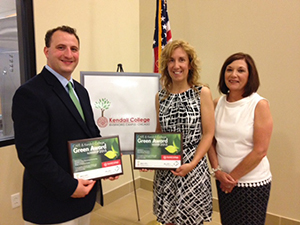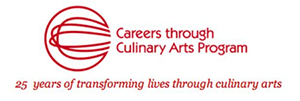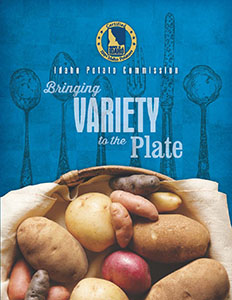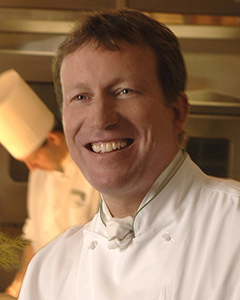Green Tomato: Kendall College and CAFÉ Announce 2015 Green Award Recipients
 High-school culinary-arts programs in Grand Rapids, Mich., and Batavia, N.Y., earn honors for exemplary practices in—and innovative teaching of—ecological sustainability.
High-school culinary-arts programs in Grand Rapids, Mich., and Batavia, N.Y., earn honors for exemplary practices in—and innovative teaching of—ecological sustainability.
Kendall College, Chicago, and the Annapolis, Md.-based Center for the Advancement of Foodservice Education (CAFÉ) presented 2015 CAFÉ/Kendall College Green Awards to two secondary hospitality programs during a June 18 reception at CAFÉ’s 11th-annual Leadership Conference for foodservice educators at Niagara Falls Culinary Institute, Niagara Falls, N.Y.
Among dozens of submissions from secondary and postsecondary programs nationwide, Kent Career Technical Center in Grand Rapids, Mich., received this year’s top award. According to chef-instructor Sarah Waller, who teaches advanced baking and pastries at Kent, the $1,000 grant from Kendall College will help fund the high school’s goal to become the first water-bottle-free secondary school in Michigan.

 On Monday, May 11, fine-dining connoisseurs are invited to enjoy the modern French cuisine of Mélisse (
On Monday, May 11, fine-dining connoisseurs are invited to enjoy the modern French cuisine of Mélisse ( Peter “Pete” Mondavi, Jr., scion of one of Napa Valley’s leading winemaking families, was keynote speaker at the March 27, 2015, graduation ceremony for the Accelerated Wine and Beverage and Accelerated Culinary Arts certificate programs at The Culinary Institute of America at Greystone in St. Helena, Calif. Mondavi advised graduates to use their newly honed skills to help people’s dining experiences become a break from the fast-paced cell-phone world.
Peter “Pete” Mondavi, Jr., scion of one of Napa Valley’s leading winemaking families, was keynote speaker at the March 27, 2015, graduation ceremony for the Accelerated Wine and Beverage and Accelerated Culinary Arts certificate programs at The Culinary Institute of America at Greystone in St. Helena, Calif. Mondavi advised graduates to use their newly honed skills to help people’s dining experiences become a break from the fast-paced cell-phone world. Idaho® potatoes—the term refers to their source of origin—are renowned for quality and reliability in all 50 states. While most consumers and foodservice operators associate the Idaho trademark with russet potatoes, Idaho growers are seeding fields with new varieties to meet a burgeoning demand for reds, yellows and other niche varietal potatoes.
Idaho® potatoes—the term refers to their source of origin—are renowned for quality and reliability in all 50 states. While most consumers and foodservice operators associate the Idaho trademark with russet potatoes, Idaho growers are seeding fields with new varieties to meet a burgeoning demand for reds, yellows and other niche varietal potatoes. Washington, D.C.-based Green America, a national nonprofit organization working to create a green economy, issued the following statement on April 27 in response to Denver-based ChipotleMexican Grill’sannouncement of removing GMOs from its foods:
Washington, D.C.-based Green America, a national nonprofit organization working to create a green economy, issued the following statement on April 27 in response to Denver-based ChipotleMexican Grill’sannouncement of removing GMOs from its foods: Say a menu item doesn’t sell. Is it overpriced, poorly described, not satisfying to the customer or a combination of these? To understand the basics of restaurant-performance management systems, here are three key teachings that would be part of any 101-level course on the topic.
Say a menu item doesn’t sell. Is it overpriced, poorly described, not satisfying to the customer or a combination of these? To understand the basics of restaurant-performance management systems, here are three key teachings that would be part of any 101-level course on the topic. Serving a term of 18 months, Carroll is joined by John Sloane of Macau as vice president of the global organization serving 10 million chefs from more than 105 nations.
Serving a term of 18 months, Carroll is joined by John Sloane of Macau as vice president of the global organization serving 10 million chefs from more than 105 nations. Hot sauce is becoming ubiquitous in homes and at foodservice outlets, according to recent NPD Group research. And while the classic Louisiana type still rules, it’s by far not the only hot seller, evidenced by spreading-like-wildfire sales of fruity habanero and chipotle varieties.
Hot sauce is becoming ubiquitous in homes and at foodservice outlets, according to recent NPD Group research. And while the classic Louisiana type still rules, it’s by far not the only hot seller, evidenced by spreading-like-wildfire sales of fruity habanero and chipotle varieties. The 10 best-selling categories have shifted since just 2013, and today, cheese is still tops, but refrigerated pasta, functional beverages and nut and seed butters show big gains. Why should we care? Because foodservice is an increasingly important sector to that industry, with growth of nearly 31% since 2012.
The 10 best-selling categories have shifted since just 2013, and today, cheese is still tops, but refrigerated pasta, functional beverages and nut and seed butters show big gains. Why should we care? Because foodservice is an increasingly important sector to that industry, with growth of nearly 31% since 2012. Fresh mango, in abundance this summer, delivers flavor, color, texture and nutrition to menus. To celebrate, Chef Allen Susser shares his recipe for a refreshing fruit salad.
Fresh mango, in abundance this summer, delivers flavor, color, texture and nutrition to menus. To celebrate, Chef Allen Susser shares his recipe for a refreshing fruit salad.